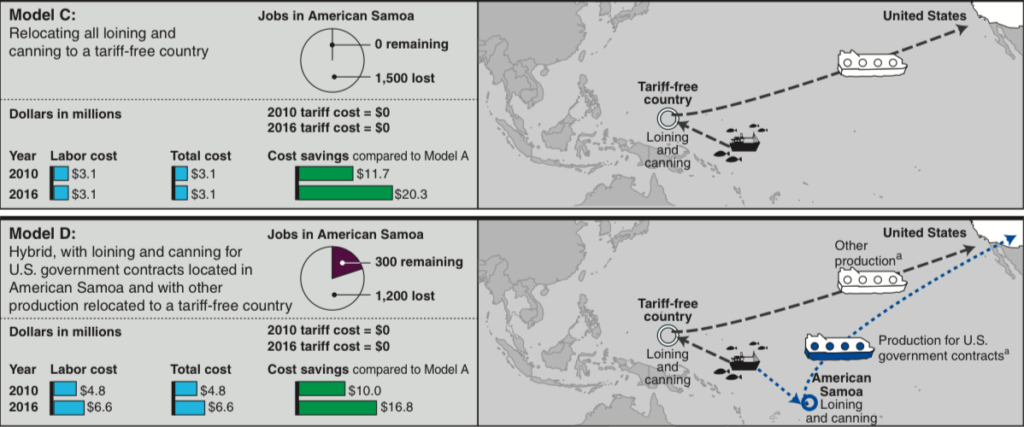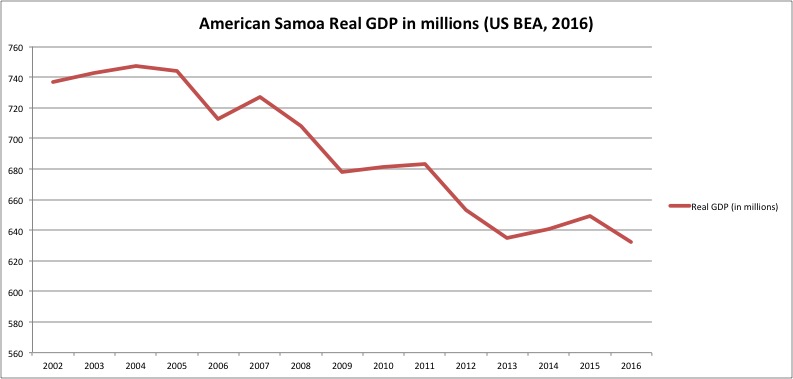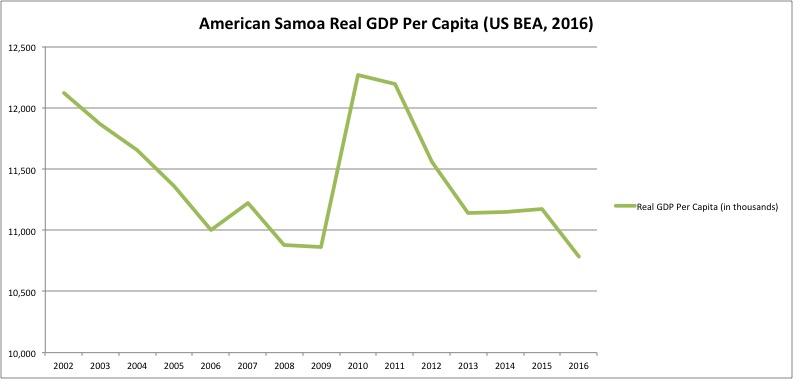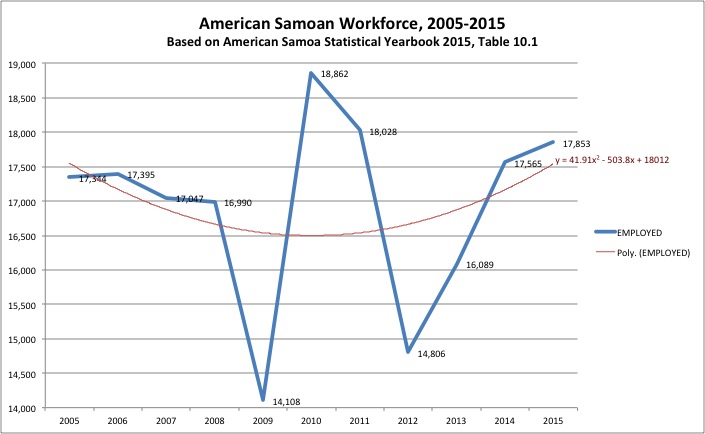
I regularly tune in to Dilbert cartoonist Scott Adams’ political rants on Periscope. During a recent philippic, he mentioned in passing that federal minimum wage laws recently devastated American Samoa’s once-booming economy. He basically painted a picture of a paradise-turned-ghetto with equality-of-outcome economic policies to blame. I, of course, had to look into this claim. Here is what I found.
Lead-up to the new minimum wage
The first thing I found is that the law in question is the Fair Labor Standards Act (FLSA). The FLSA is a collection of laws that require most employers to pay most workers a minimum wage as well as overtime.While originally passed in 1938, Congress has amended it a gazillion times since.1
Historically, the majority party in Congress tends to get the opposition party and the President to sign off on contentious FLSA amendments by including them as part of larger, must-pass appropriations bills. For instance, the change in the FLSA to which Scott Adams was referring is called the Fair Minimum Wage Act of 2007 (FMWA).2 Introduced to the House for consideration by Rep. George Miller (D-CA), it was included in the succinctly-named U.S. Troop Readiness, Veterans’ Care, Katrina Recovery, and Iraq Accountability Appropriations Act of 2007 (Pub. L. No. 110–28). 3,4 Pub. L. No. 110-28 funded the US military’s ongoing efforts in Afghanistan and Iraq (priority numero uno for then-president George Bush) and also provided billions in funding for Hurricane Katrina recovery efforts.
Thanks in part to American Samoa’s congressional delegate, Eni F.H. Faleomavaega (a Democrat), while the FMWA increased the federal minimum wage to $7.25/hour, its original form (H.R.2) exempted American Samoa.4,5 However, congressional Republicans, including the Resident Representative to the United States from the U.S. Commonwealth of the Northern Mariana Islands (CNMI), Pedro Agulto Tenorio (a Republican), balked at exempting a territory represented by a Democrat while not excepting one represented by a Republican.6 Rep. Eric Cantor (R-Va.) fumed that it was an “abuse of power”5 while Rep. Patrick McHenry (R-N.C.) quipped, “There’s something fishy going on here.”7
Republicans pointed out that Speaker of the House Nancy Pelosi’s (D-Ca.) district included San Francisco where Del Monte Foods, Inc. was headquartered. At the time, Del Monte owned Pittsburgh-based tuna producer StarKist Co.8 StarKist’s tuna canning plant, along with San Diego-based rival Chicken of the Sea International’s plant, employed a little over 27%A of American Samoan workers.9,10 Republicans suggested that Del Monte had leaned on Pelosi who in turn had influenced her congressional underlings to exempt the small island group from their minimum wage legislation.
Pelosi quickly buckled under congressional Republican pressure. On January 17, 2007, Rep. Mark Steven Kirk (R-IL) submitted an amendment to the act (H.R.509 – Minimum Wage for All Americans Act), extending its minimum wage requirement to American Samoa.11 In light of Faleomavaega’s (and others’) predictions of economic ruin12 for the small island group, Congress, while passing the FMWA, ordered an economic study from the U.S. Department of Labor (DOL) assessing and predicting impacts of the law. The study was to be delivered no later than 8 months after the FMWA took effect. The analysis that follows is based largely on that report and subsequent reports.B
Aftermath
2007
The FMWA required annual increases of 50¢ in American Samoa’s minimum wage until it reached $7.25/hr. The territory’s minimum wage at the time was set by industry committees and varied from $2.68 to $4.09. In 2007, the first incremental wage increase took effect with no immediately measurable impact on the economy.10
2008
In 2008, the second incremental wage increase took effect. Also, the so-called Great Recession hit the US. Its effects would slowly ripple out to American Samoa and the rest of the world.
Early in the year, two reports discussing American Samoa’s economic future were published: one by the US Department of Labor,10 and one by the American Samoan government.13 Each relied upon the other’s data and findings. Those findings are summarized below.
In 2006, one year before passage of the FLSA, American Samoa’s economy was composed of three primary sectors: government (34%), tuna canning (27%) and everything else (39%). The government itself was largely funded by federal grants and operated at a loss.10
Even before FMWA passage, for American Samoa’s tuna canneries, the future was fraught with peril. Canneries in the (relatively nearby) Phillippines and Thailand operated at significantly lower wages, sealed foil packaged tuna was displacing canned tuna in grocery stores, and NAFTA provisions taking effect in 2008 promised to make packaging and shipping tuna from Mexico into the U.S. more cost- and time-efficient.10 Basically, the last thing American Samoa needed was a mandatory wage increase.
American Samoan workers already employed at the new federal minimum wage level of $7.25/hr represented roughly the 80th percentile of wage-earners on the islands. So the new standard, to be phased in over several years, represented something of a sea change. The DOL’s study pretty much confirmed the doom-and-gloom predictions: American Samoa’s anything-but-diverse economy would be hard-hit by the new wage requirements. The canneries would either close or significantly scale-back operations, and the (largely US-grant-funded) government would also have to either layoff or slash the hours of quite a few folks and scale back services and investments in infrastructure.10
The DOL predicted an increase of 33% in wage costs across American Samoa and dourly posited “it is not likely that such an increase in wages could be absorbed through increased productivity, reduced profits, or higher prices.” Representatives for the local canneries provided numbers suggesting that (1) profits for their canned tuna operations were already minimal, (2) that the minimum wage increase would more than double labor costs and completely eliminate profits, and (3) that a worldwide excess of 20-40% in canned-tuna processing capacity ensured that moving canning operations to a location with a lower wage floor could be effected quickly and at little or no expense.10
A separate study, commissioned by the American Samoan government, found an “implicit multiplier effect” of 1.47 for every tuna processing job. In other words, for every two jobs a cannery added or subtracted, 1 additional job would come or go elsewhere in the economy. If both canneries closed, total jobs lost were estimated at around 8,000, or 46% of all jobs. Despite its near total reliance on federal funding, the Samoan government’s report assessed that federal involvement in the local economy had resulted mostly in harm to American Samoa. The way forward, the report stated, would be economic diversification by enticing new and varied industries to the islands through tax benefits and reduced regulation. Specifically, the government hoped for “internet-based” employment for locals in the form of call center and data processing opportunities.13
2009
In 2009, the third incremental wage increase took effect bringing the minimum wage to $4.18/hr. By now, the US’s Great Recession had rippled out into a global recession, exacerbating financial stressors already besieging the tuna processing industry.14
Also in 2009, in response to the Great Recession, Congress passed a stimulus package (Pub. L. No. 111–5) which they named the American Recovery and Reinvestment Act (ARRA). Buried in its provisions was a temporary increase in federal block grants to American Samoa and an amendment to the FMWA requiring the Government Accountability Office (GAO) provide an annual report on the economic impact of the 2007 minimum wage law on American Samoa. Since the GAO’s annual reports would report on the prior year, the 2010 report’s findings are summarized below. Congress also stalled the wage increase scheduled for 2010 (See Pub. L. No. 111-117).14
In September 2009, Chicken of the Sea permanently closed their American Samoa tuna cannery, moving its canning operation to the US State of Georgia and its loining operations to lower-wage countries. The territory’s employment rate was now down 22% since 2006.15
About 3/4 of private sector workers for whom the law applied (including those employed at the now-shuttered cannery) had seen a wage increase. Tuna cannery workers saw the highest increase with a median wage increase of 44%. Unfortunately, the pay raises were offset by closures, fewer scheduled work hours, and reductions in benefits, inter alia.14
An earthquake and tsunami caused “sever damage” to the country this year, though federal assistance helped as did temporary disaster recovery jobs.16
2010
In 2010, the GAO published its first report (GAO-10-333) in compliance with Pub. L. No. 111–5. In September 2010, Congress again put pay increases on hold through 2011 and also reduced the GAO’s reporting requirement from annual to biennial (See Pub. L. No. 111-244).15
As predicted, the Samoan government faced increased budget shortfalls and had cut government employees’ hours. While the minimum wage had increased the earnings of the lowest-paid Samoans (or at least those who had not yet lost their jobs) by 23%, overall inflation-adjusted earnings were down 2% while prices were up 3% (Since 2006). Tuna industry reps expressed growing concern for the future stemming from the FMWA, the Andean Trade Preference Act and NAFTA.15
One positive thing did happen in 2010. In October, Samoa Tuna Processors, Inc., a subsidiary of Tri Marine International (of Bellevue, Washington), bought the former Chicken of the Sea cannery in the Samoan village of Atu’u. In order to retain the various benefits the Samoan government extended, it would have to employ at least 600 people and spend at least $5 million over the next 5 years.15
2011
In June 2011, the GAO published its second annual report (GAO-11-427) on post-FMWA American Samoa. Most of its relevant finding are summarized above.
The GAO analyzed various possible paths forward for the tuna industry and concluded that remaining even partly in American Samoa would be less profitable than moving all operations elsewhere.15

By the end of 2011, Tri Marine International still had not reopened the former Chicken of the Sea cannery.16
2012
In July 2012, Congress passed Public Law 112-149 stalling additional wage increases until 2015, reducing the frequency of incremental increases from annual to triennial and further reducing the GAO’s reporting requirement from biennial to triennial, requiring the first report be submitted by April 2014.
American Samoa’s real GDP had declined 4.5% since 2006. That said, due to a declining population, real GDP per capita had increased 12.5% over the same period. The government employed 36% of workers (up from 34% in 2007), and the tuna industry employed 12% (down from 27%).16
The American Samoan Territorial Planning Committee released a federally-funded economic development report in 2012. Among other things, it asserted that increased federal funding was the only reason the territory was not experiencing an all-out economic depression resulting from the FMWA, the Great Recession and the tsunami of 2009. The committee reported that federal funding had increased from $257 million in 2008 to $515 million in 2010. The report attributed most of government job growth to temporary federal economic- and disaster-relief funding and warned that a downturn was all but inevitable. While acknowledging hat the federal government was propping up the Samoan economy, the committee also blamed it for most of the territory’s economic woes while admitting that the Samoan government’s own practices were partly to blame.17
By the end of 2012, Tri Marine International still had not reopened the former Chicken of the Sea cannery.
2013
By 2013, Samoan employment in the tuna industry was down 58% since 2006. Overall employment was down 11%. Inflation-adjusted earnings for those who were employed was down 3% since 2006.16
By the end of 2013, Tri Marine International still had not reopened the former Chicken of the Sea cannery.16
2014
In March 2014, the GAO published its third report on the effects of the FMWA on American Samoa. The Samoan government challenged many of the report’s numbers, arguing that things in American Samoa were much worse than reported and stating that, going forward, American Samoa should be allowed to set its own minimum wage.16
The government employed 42% of workers (up from 34% in 2007 and 36% in 2012), and the tuna industry employed 14% (down from 27% in 2007 but up from 12% in 2012). Overall employment was down 4% from 2007, and cannery employment was down 50%.18
The Tri Marine facility began processing tuna in 2014 and was scheduled to begin canning operations in 2015 with a projected employee count of around 1,200.18
2015
In October 2015, Congress passed Public Law 114-61 ending future minimum wage hikes in American Samoa and changing the scope of the triennial GAO report from analyzing the effects of the FMWA on the Samoan economy to proposing alternative methods of improving wages in the region.
The Tri Marine cannery began operations in January 2015 after $70 million in start up costs.19
2016
In December 2016, the GAO published the first triennial report (GAO-17-83) required of it by Pub. L. No. 114-61. Just days before publication, Tri Marine suspended canning operations indefinitely. The facility had 600 employees. Samoan congressional delegate Eni F.H. Faleomavaega’s successor, Aumua Amata, cited “misguided government policies” as a primary factor in the cannery closure. The company stated that it would continue its non-cannery operations in the region.1816
The GAO’s report noted that the StarKist cannery had also suspended operations in 2016, temporarily, twice, due to a lack of fish. Both companies, StarKist and Tri Marine, complained about recent regulations reducing the amount of tuna that could be fished near Samoa as causing significant supply shortages.18
In its 2008 report, the Samoan government expressed interest in diversifying its economy with an eye towards attracting call centers to the region. In furtherance thereof, in 2016, it announced plans to begin construction on a new food processing plant by year end. It was also involved in efforts to attract a call center to the area, but so far those efforts had not borne fruit.18
The GAO requested input from 4 external reviewers (3 PhDs and a former Congressional Research Service policy analyst) regarding what should be done with American Samoa’s minimum wage. One suggestion made by the reviewers was that, if Congress insisted on raising the minimum wage, industries less sensitive to labor cost increases/fluctuations should first be identified and enticed to the territory. Three of the 4 reviewers expressed doubt that basing the Samoan minimum wage on the US mainland’s was logical. Two reviewers doubted basing the minimum wage on local cost of living estimates made any more sense. Finally, 1 reviewer suggested making future minimum wage increases proportionate to federal minimum wage increases. In other words, if the federal minimum wage were to increase by $1 from $7.25 to $8.25 (an increase of 13.8%), the Samoan minimum wage would increase by 13.8% rather than by $1.18
The GAO did not recommend a way forward other than to pass the buck back to the Department of Labor, suggesting the DOL should research the topic for Congress.18
Analysis

So, did federal minimum wage laws kill American Samoa? Well, not exactly, but they did kick the shit out of her while she was down. In January 2007, when Rep. Miller first introduced the FMWA to the House, American Samoa was already struggling. Its biggest sector was government, and that was funded mostly by federal grants and operating in the red. Its second biggest was tuna processing, and that was becoming less profitable by the year. Samoa was experiencing a declining native-born population, declining GDP, and a failing single-industry private sector.
After passage of the FMWA, the American Samoan economy’s slow decline became a nosedive beginning with the 2009 closure of one of two of the territory’s tuna canneries. From 2006 to 2016, the US Bureau of Economic Analysis (yeah, I’d never heard of ’em before either) reported American Samoa’s real GDP declined by 11% while real GDP per capita declined by 2%.20,C

An obvious measure of the impact of the FMWA on American Samoa would be to compare the unemployment rate before and after passage of the act. Unfortunately, because American Samoa is a unincorporated territory and not a state, accurate statistics can be hard to come by. Looking at census data, the DOL extrapolated a 2000 unemployment rate of 5.2% while the GAO calculated the unemployment rate in 2010 at 9.2%.10,16 The American Samoan government considers these numbers low, estimating the 2012 unemployment rate to be as high as 18%.16

In 2010, about 57.8% of the population lived below the US poverty line.21 Sadly, this is actually better than the over 60% reported for the 2000 census.22 Unfortunately, while the Samoan Department of Commerce publishes a quarterly employment statistics report, that report does not attempt to estimate the unemployment rate, so a more recent rate is unavailable. Seeing as, in 2010, many of the jobs recently added were temporary federally-funded disaster-relief jobs, it is likely those opportunities have since expired and unemployment is higher now than in 2010.
So, yes, American Samoa is worse off because Congress increased the territory’s minimum wage by 37%-56% (depending on industry) over a 3 year period.10 That said, the narrative Scott Adams suggested–of equality of outcome economic policies gone amok–is inaccurate. In actuality, no one in Congress thought increasing American Samoa’s minimum wage to US mainland levels was a good idea. Rather, to win political points, a handful of Republican politicians forced the hand of the new Democratic Speaker of the House, and she and her underlings caved under the pressure.
American Samoa’s minimum wage debacle is a story of amoral, cut-throat politics at its worst. The politicians involved, on both sides of the aisle, were more concerned with scoring points for their perpetual reelection campaigns than in doing what was right for a small population of impoverished US nationals.
Footnotes
A. A number of articles I read while researching this subject cited a 2004 number of 40% employment by the two canning sites. Most of these articles were written in 2007, before the January 2008 Department of Interior report was published.↩
B. The DOL report covered both American Samoa and the CNMI; however, this article only discusses the American Samoa findings.↩
C. The BEA’s numbers don’t match the DOL and GAO numbers, but the trends are similar.↩
References
1. Fair Labor Standards Act of 1938. (n.d.). In Wikipedia. Retrieved January 14, 2017, from https://en.wikipedia.org/wiki/Fair_Labor_Standards_Act_of_1938↩
2. Fair Minimum Wage Act of 2007. (n.d.). In Wikipedia. Retrieved January 14, 2017, from https://en.wikipedia.org/wiki/Fair_Minimum_Wage_Act_of_2007↩
3. U.S. Troop Readiness, Veterans’ Care, Katrina Recovery, and Iraq Accountability Appropriations Act of 2007. (n.d.). In Wikipedia. Retrieved from https://en.wikipedia.org/wiki/U.S._Troop_Readiness,_Veterans%27_Care,_Katrina_Recovery,_and_Iraq_Accountability_Appropriations_Act,_2007↩
4. House of Representatives Resolution 2. (2007). Retrieved from https://www.congress.gov/bill/110th-congress/house-bill/2↩
5. Weisman, J. (2007, January 9). Minimum-wage bill stirs controversy in Pacific Islands. The Washington Post. Retrieved from http://www.washingtonpost.com/wp-dyn/content/article/2007/01/08/AR2007010801641.html↩
6. United States congressional delegations from the Northern Mariana Islands. (n.d.). In Wikipedia. Retrieved from https://en.wikipedia.org/wiki/United_States_congressional_delegations_from_the_Northern_Mariana_Islands↩
7. Pelosi’s tuna surprise. (2007, January 16). The Wall Street Journal. Retrieved from https://www.wsj.com/articles/SB116891896808477346↩
8. American Samoa minimum wage: Was House Speaker Nancy Pelosi involved in providing wage and tax breaks to American Samoa? (2010, April 5). Snopes.com. Retrieved from https://www.snopes.com/politics/pelosi/americansamoa.asp↩
9. Lathem, N. (2007, January 13). Pelosi bill blasted as pork for tuna. New York Post. Retrieved from https://nypost.com/2007/01/13/pelosi-bill-blasted-as-pork-for-tuna/↩
10. United States Department of Labor, Office of the Assistant Secretary for Policy. (2008, January). Impact of increased minimum wages on the economies of American Samoa and the Commonwealth of the Northern Mariana Islands. Washington, DC: Government Printing Office. Retrieved from https://www.doi.gov/sites/doi.gov/files/migrated/oia/reports/upload/ascnmi.pdf↩
11. House of Representatives Resolution 509. (2007). Retrieved from https://www.congress.gov/bill/110th-congress/house-bill/509↩
12. United States House of Representatives, Office of Congressional Delegate Eni F.H. Faleomavaega. (2007, January 10). Faleomavaega comments on minimum wage bill now before Congress [Press release]. Retrieved from https://web.archive.org/web/20080101062246/http://www.house.gov/apps/list/press/as00_faleomavaega/minimumwage2007.html↩
13. Conway, D.; Wolman, L. (2008, February). American Samoa’s economic future and the cannery industry. Produced by Malcolm D. McPhee & Associates for the American Samoa Department of Commerce. Retrieved from http://americansamoarenewal.org/sites/default/files/resource_documents/canneries.pdf↩
14. United States Government Accountability Office. (2010, April 8). American Samoa and the Commonwealth of the Northern Mariana Islands: wages, employment, employer actions, earnings, and worker views since minimum wage increases began (GAO-10-333). Washington, DC: GAO. Retrieved from https://www.gao.gov/assets/310/302883.pdf↩
15. United States Government Accountability Office. (2011, September 23). Testimony
before the Fisheries, Wildlife, Oceans, and Insular Affairs Subcommittee, Committee on Natural Resources, House of Representatives: American Samoa and the Commonwealth of the Northern Mariana Islands: employment, earnings, and status of key industries since minimum wage increases began: statement of David Gootnick, Director of International Affairs and Trade (GAO-11-956T). Washington, DC: GAO. Retrieved from https://www.gao.gov/assets/590/585362.pdf↩
16. United States Government Accountability Office. (2014, March 31). American Samoa and the Commonwealth of the Northern Mariana Islands: economic indicators since minimum wage increases began (GAO-14-381). Washington, DC: GAO. Retrieved from https://www.gao.gov/assets/670/662127.pdf↩
17. American Samoa Department of Commerce, Territorial Planning Commission. (2012, August 6). American Samoa’s comprehensive economic development strategy, 2012. Pago Pago: ASG. Retrieved from https://www.doi.gov/sites/doi.gov/files/migrated/oia/reports/upload/American-Samoa-CEDS_2012__First_Draft__9.pdf↩
18. United States Government Accountability Office. (2016, December 2). American Samoa: alternatives for raising minimum wages to keep pace with the cost of living and reach the federal l,evel (GAO-17-83). Washington, DC: GAO. Retrieved from https://www.gao.gov/assets/690/681370.pdf↩
19. Sagapolutele, F. (2016, October 13). Tuna cannery in American Samoa to halt production. The Seattle Times. Retrieved from https://www.seattletimes.com/business/tuna-cannery-in-american-samoa-to-halt-production/↩
20. United States Department of Commerce, Bureau of Economic Analysis. (2017, August 14). Gross Domestic Product (GDP) for the U.S. Territories, American Samoa (Table 1.2). Retrieved from https://www.bea.gov/national/gdp_territory.htm↩
21. American Samoa Department of Commerce. (n.d.). American Samoa Statistical Yearbook 2015. Retrieved from http://doc.as.gov/research-and-statistics/statistical-yearbook/↩
22. United Sates Census Bureau. (2000, revised 4 May 2004). American Samoa: Population and Housing Profile. Retrieved from https://www.census.gov/census2000/americansamoa.html↩